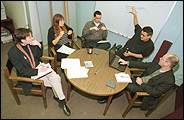Time to get serious about the web
Time to get serious about the web McGill University
User Tools (skip):
Time to get serious about the web
| If you've recently visited the University's web site, the McGill Gateway, and scrolled down to the contact information at the bottom of the page, you might have noticed a unit called the Web Communications Group listed. And you might have thought to yourself, "The Web Communications What?"

WCG members from left to right, Tanya Steinberg, Marci Denesiuk, Christopher Murtagh, Eric Smith and Karl Jarosiewicz PHOTO: OWEN EGAN | |
The WCG is only a few months old and it doesn't have a high profile just yet. But that's likely to change soon.
"What we are is a unit created to help McGill publish professionally on the web," says Karl Jarosiewicz, the WCG's managing editor. "This represents the first attempt at creating a central web source for the entire community. Our goal is to create a system that will enable everyone to be able to publish their information at a consistently professional level."
According to Jarosiewicz's new boss, Vice-Principal (Information Systems and Technology) Bruce Pennycook, professional looking, thoughtfully designed and meaty web sites are now a necessary part of how a university interacts with the world around it.
The days of units using a fly-by-the seat-of-their-pants approach to promoting themselves on the web are over. If a web site looks amateurish, if it frustrates potential students or research collaborators who are searching for particular kinds of information, it makes the whole university look bad.
"For instance, within only a few years, the web has become the premiere vehicle students use to gather information about the universities they might attend. At the graduate level, about 70 per cent of students look for their universities that way," Pennycook says. We don't want to blow that first impression.
"When the web started, it was a lot of fun to put together your own site," adds Pennycook. "But by the third or fourth time you revise it — and you have to keep revising it otherwise you become stale and out of date -- it's not that interesting anymore."
In putting together the Gateway, the linchpin of McGill's web efforts, Jarosiewicz says the WCG uses a magazine-like format. The aim is to offer an attractive and consistent-looking package with some newsy tidbits about McGill upfront and a quick pathway to other essential McGill sites.
Jarosiewicz says the WCG's guiding principle is to make McGill's various web offerings as inter-connected and easy-to-find as possible.
A former communications officer in the University Relations Office, Jarosiewicz says the URO's initial web site, which he helped put together, was attractive and engaging but, in some respects, a failure.
"Nobody came to McGill's web site looking for the URO. We were buried. But people were interested in what we produced - the McGill Reporter, our press releases." URO's output is now better integrated into the Gateway as a whole.
"What people shouldn't be doing is publishing a web site about their own particular office, so much as publishing material about the part of the University that they manage.
"When someone comes to the Gateway, they expect to come to McGill, not to a hodge-podge of 150 units. A certain level of consistency is important."
Some of the WCG's initial customers include the Faculty of Agricultural and Environmental Sciences, the Centre for Continuing Education, the Department of Human Resources and the Office for Technology Transfer.
"If you can publish a page of text, if you can supply the content for your unit and update it, you can have a web site. We'll supply the architecture.
"What are people looking for on the web?," posits Jarosiewicz. "When they come to a university, they usually want information about a department's academic programs and about the professors' expertise." He says a surprising number of academic units fail to supply that information in a coherent and easy-to-digest manner.
"Web pages are different from other media. You have to have content, but it has to be layered. If you just throw up all sorts of text and information, people will be turned off." You have to offer information of substance, but in a snack-sized format. "People want to get the flavour of your site, they want to get the gist of what you're about. If they're interested, they'll dig deeper -- as long as you make it easy for them."
Apart from managing the Gateway and helping units develop their own web presence, the WCG will be busy developing programming and design tools, and for units that are still inclined to do it themselves, web publishing guides. In the months to come, Pennycook expects the WCG to collaborate with the Banner Information Systems Project in making McGill's web sites more interactive. The vice-principal envisions a future where most of a students' business with McGill, from paying fees to changing courses, will take place on the web.
Other members of the WCG include web systems designer Eric Smith (who, along with Jarosiewicz, earned the top prize for Canadian university web site last year), programmer Christopher Murtagh and communications assistant Marci Denesiuk. Jarosiewicz also works closely with Tanya Steinberg, IT Administration's manager and WCG's general manager. Steinberg is responsible for policy development, strategic planning and representing the WCG to the senior adminstration.

